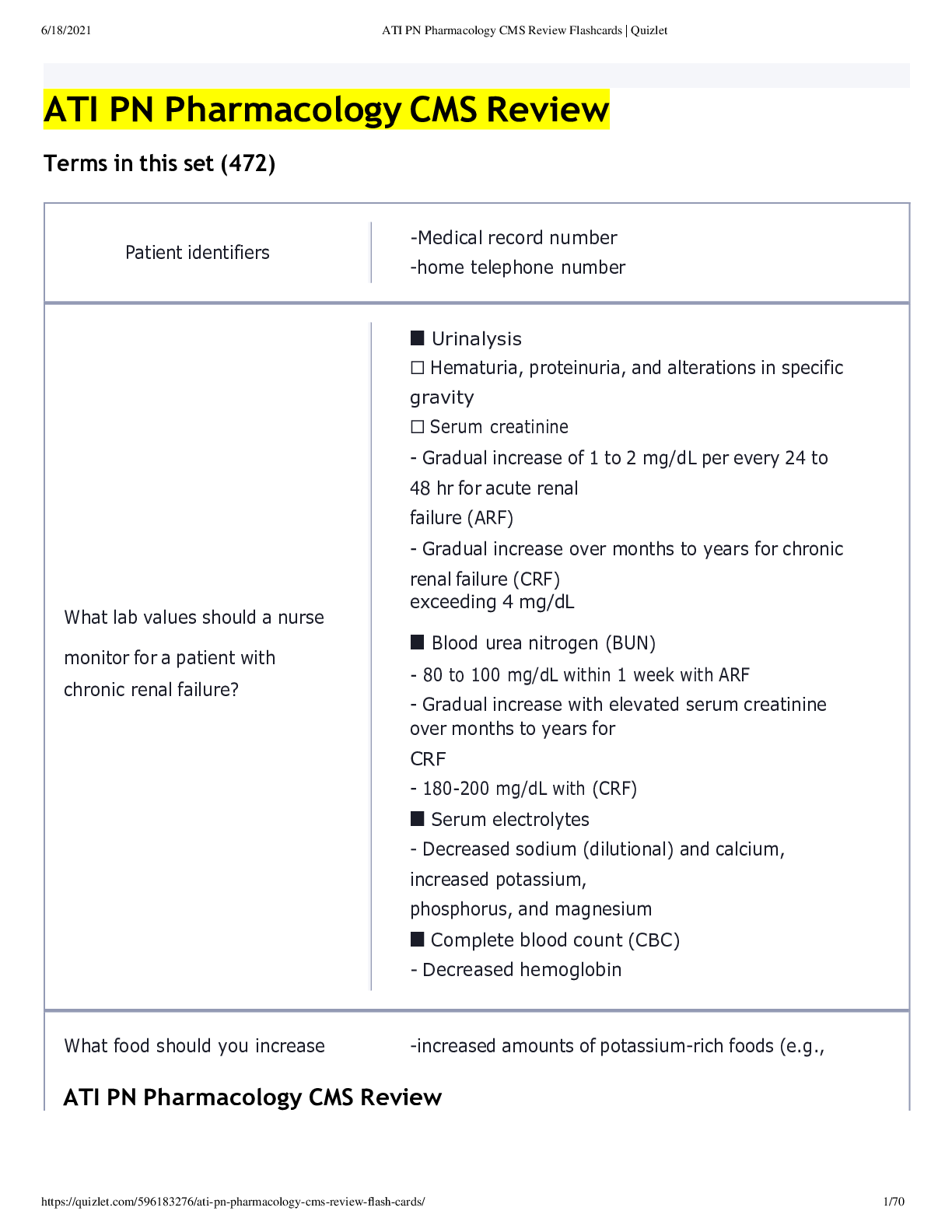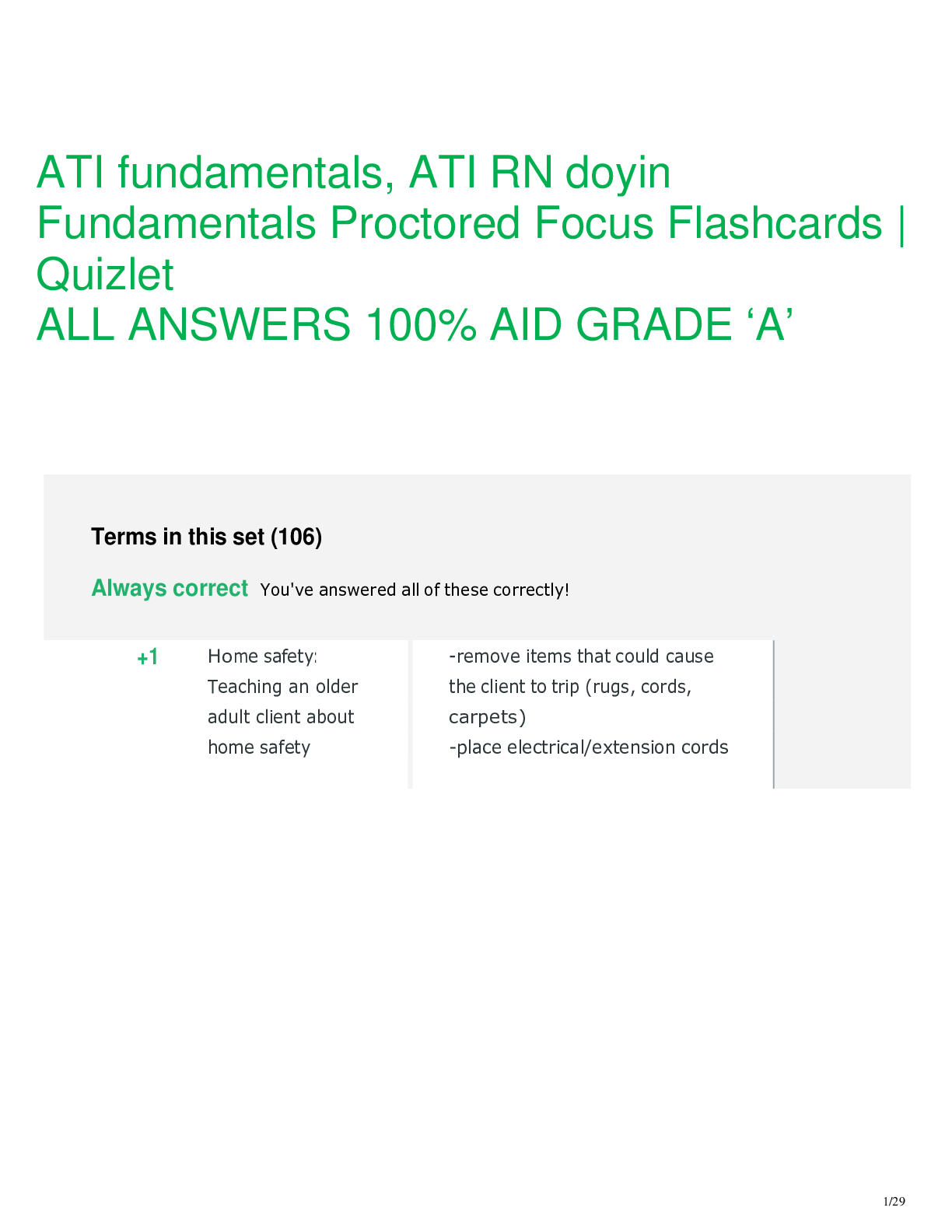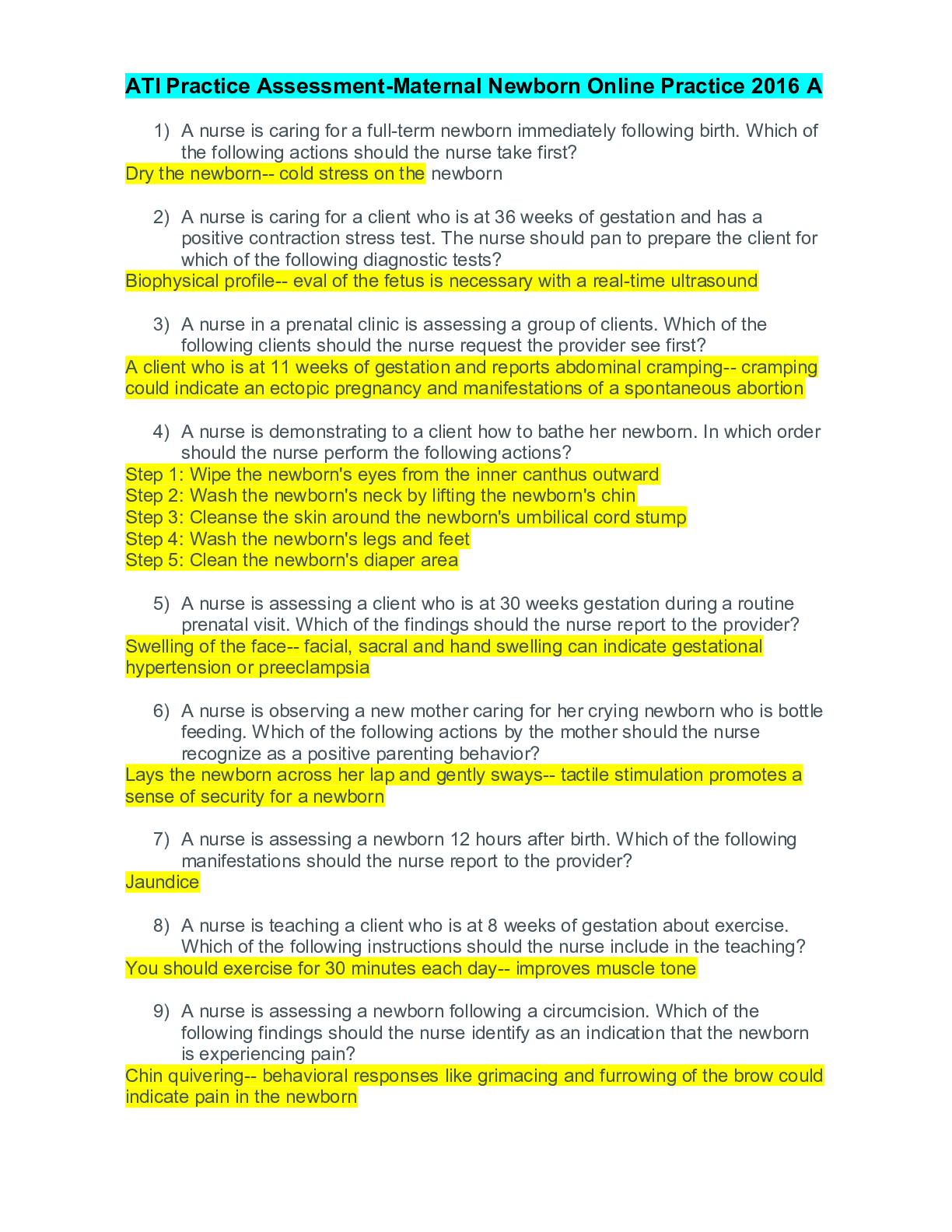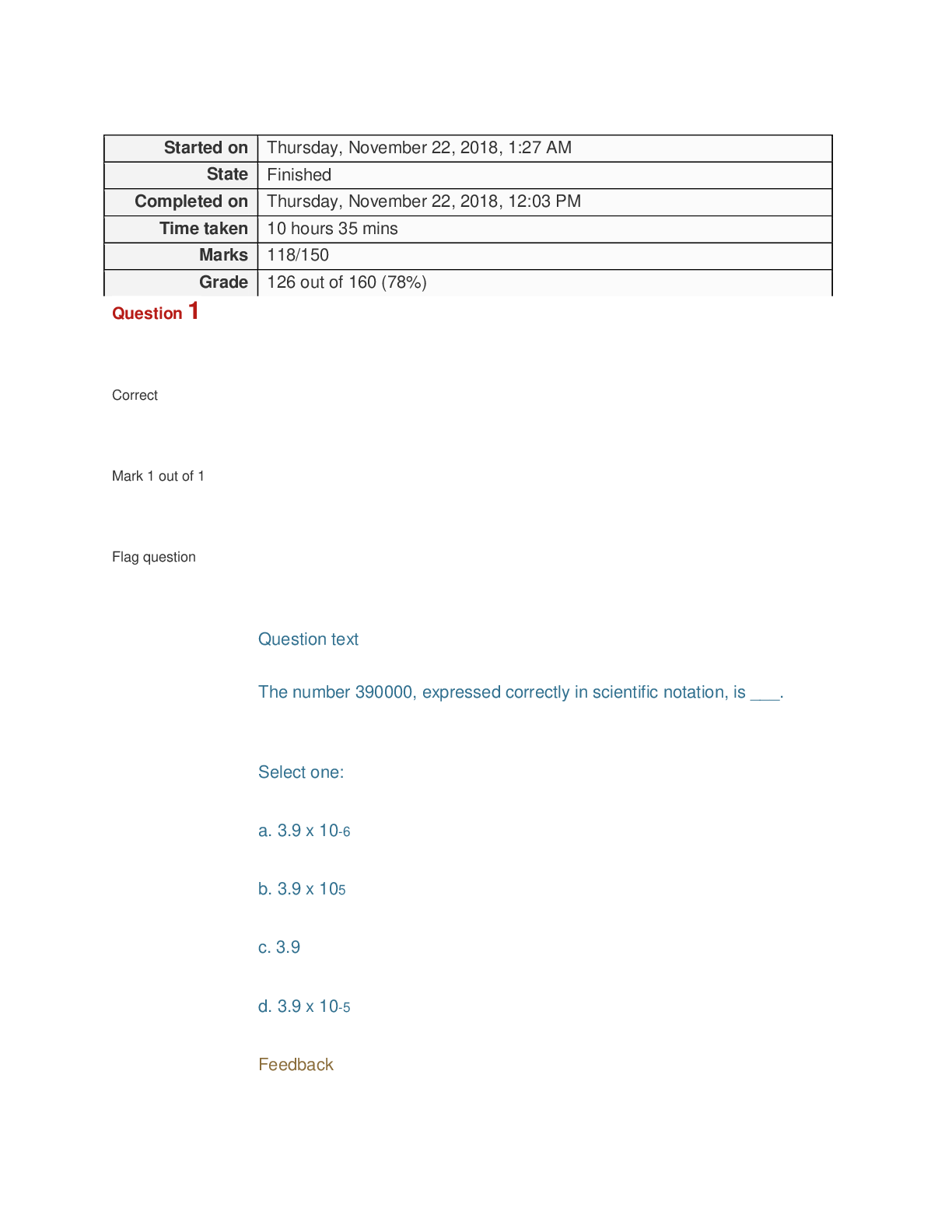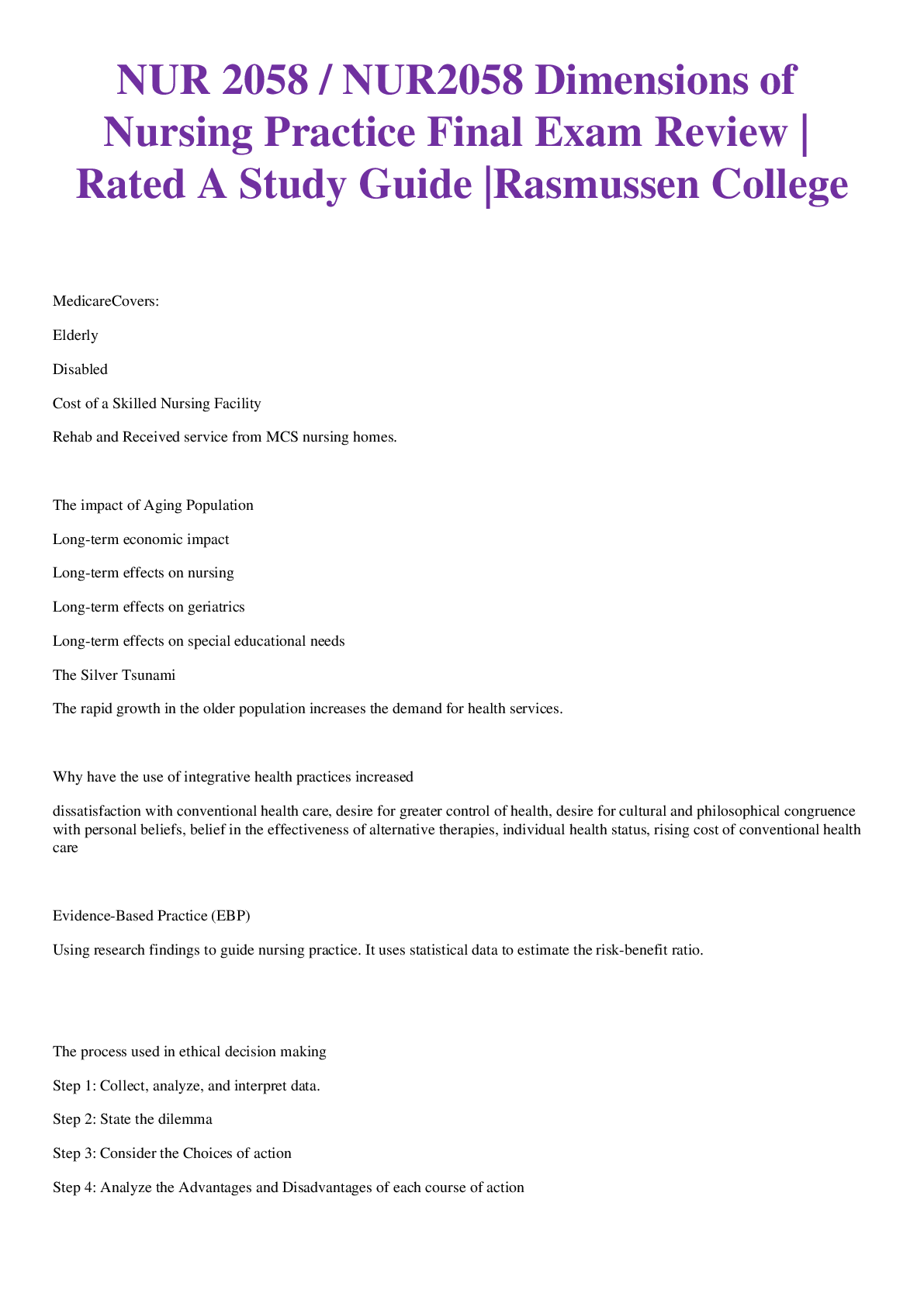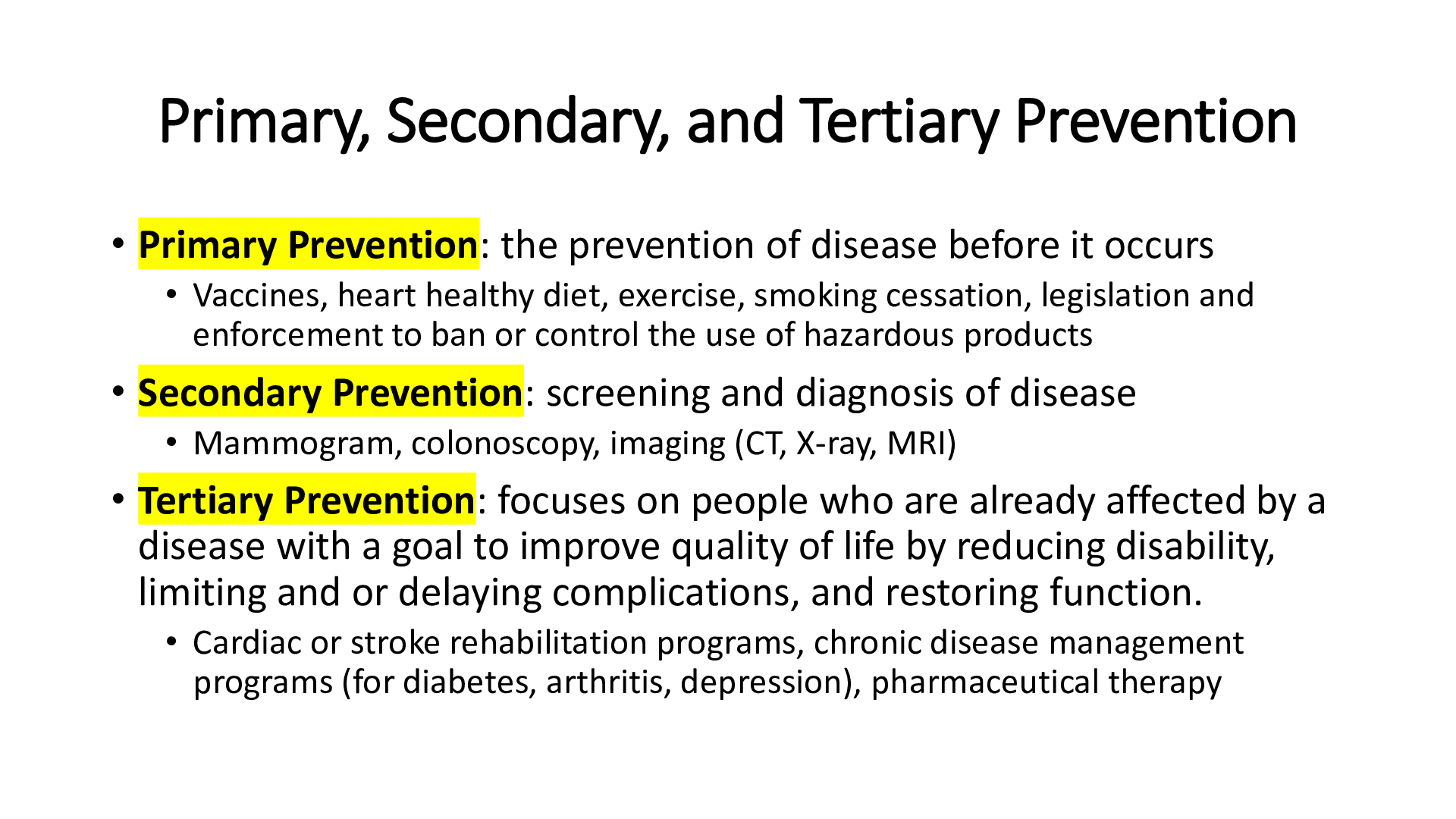*NURSING > EXAM REVIEW > Mental Health Practice 2016 A Flashcards _ Quizlet (All)
Mental Health Practice 2016 A Flashcards _ Quizlet
Document Content and Description Below
Mental Health Practice 2016 A 60 terms Annabel_Vega Terms in this set (60) A nurse is preparing to administer chlorpromazine 0.55 mg/kg PO to an adolescent who weighs 110 lb... . Available is chlorpromazine syrup 10 mg/5 mL. How many mL should the nurse administer? (Round the answer to the nearest whole number) A nurse in an emergency department is caring for a female adolescent who has a diagnosis of bulimia nervosa and had a fainting episode during a ballet performance. Which of the following statements by the mother acknowledges her daughter's . diagnosis? A. "She works so hard at ballet. Will she still be able to perform?" B. "She won't let me take the trash from her room. I'm concerned about what she has in there." C. "She told me she was tired, so I did her chores for her today." D. "She is happier with her appearance now that she's lost some weight." While observing group therapy, a nurse recognizes that a client is behaving in a way suggestive of dependent personality disorder. Which of the following behaviors is consistent with this condition? A. The client needs excessive external input to make everyday decisions. B. The client demonstrates a dedication to his job that excludes time for leisure activities. A. The client needs excessive external input to make everyday decisions. Clients who have dependent personality disorder need excessive input from others to make everyday decisions. C. The client adheres to a rigid set of rules. D. The client has difficulty starting new relationships unless he feels accepted. A nurse is caring for a child who is taking methylphenidate. The nurse should monitor the child for which of the following findings as an adverse effect of methylphenidate? A. Weight gain B. Tinnitus C. Tachycardia D. Increased salivation A nurse is interviewing a client at a temporary shelter after surviving the destruction of her home by a tornado. When assessing the client, the nurse should ask which of the following questions to determine the client's ability to cope with this situation? A. "Don't you think you'll get through this in time?" B. "To whom do you talk B. "To whom do you talk when you feel overwhelmed?" By asking this question, the nurse is assessing the client's support systems, which is an important factor in the client's ability to cope with the situation. when you feel overwhelmed?" C. "Have you thought about rebuilding your home on the same site?" D. "Would you like me to find a therapist for you to speak with?" A nurse is caring for a client who has schizophrenia and was prescribed a conventional antipsychotic medication yesterday. Which of the following findings indicates the nurse should administer benztropine 2 mg IM? . A. Shuffling gait B. Hypotension C. Decreased WBC count D. Blurred vision A nurse is reviewing routine laboratory values for several clients who are taking lithium carbonate. Which of the following clients should the nurse assess further for findings indicating lithium toxicity? A. A client who has a fasting blood sugar of 80 mg/dL B. A client who has a sodium level of 128 mEq/L C. A client who has a BUN of 18 mg/dL D. A client who has a potassium level of 3.6 mEq/L. A nurse is counseling an adolescent who has anorexia nervosa and reports excessive laxative use and a fear of gaining weight. The client states, "I'm so fat I can't even stand to look at myself." Which of the following therapeutic responses demonstrates the nurse's use of summarizing? A. "You've discussed several concerns about your weight. Let's go back and talk about your belief that you are fat." B. "You're saying that you think you are fat and are using laxatives because you are afraid of gaining weight." C. "You don't want to look at yourself because you think you are fat." D. "You and I can work together to overcome your fears of gaining weight." A nurse is planning care for a client who has generalized anxiety disorder. At which of the following levels of anxiety should the nurse plan to teach the client relaxation techniques? A. Panic B. Moderate C. Severe D. Mild A nurse in a mental health clinic is caring for a client with bipolar disorder and reports that she stopped taking lithium 2 weeks ago. The nurse should recognize which of the following as an expected adverse effect that might have caused the client to stop taking the medication? C. Hand tremors Fine hand tremors are an expected adverse effect of lithium and can interfere with the client's ADLs, causing the client to stop taking the medication. A. Sore throat B. Photophobia C. Hand tremors D. Constipation A nurse is performing a cognitive assessment to distinguish delirium from dementia in a client whose family reports episodes of confusion. Which of the following assessment findings supports the nurse's suspicion of delirium? A. Slow onset B. Aphasia C. Confabulation D. Easily distracted A nurse is teaching a family member and a client who has a new diagnosis of Alzheimer's disease and is to start taking donepezil. Which of the following statements should the nurse include in the teaching? A. "Take this medication in the evening at bedtime." B. "Expect this A. "Take this medication in the evening at bedtime." The client should take this medication in the evening at bedtime for optimal effectiveness. medication to reverse the effects of Alzheimer's disease." C. "If you miss a dose, double the next dose." D. "You can crush this medication in applesauce." A client who has a recent diagnosis of bipolar disorder is placed in a room with a client who has severe depression. The client who has depression reports to the nurse, "That man in my room never sleeps and he keeps me up too." Which of the following is an appropriate action for the nurse to take? . A. Move the client who has bipolar disorder to a private room. B. Administer sleep medication to the client who has bipolar disorder. C. Move the client who has severe depression to a private room. D. Administer sleep medication to the client who has severe depression. A client who has bipolar disorder is to be discharged home with a prescription for lithium. Which of the following statements indicates that client teaching regarding the medication has been effective? A. "I should eat a regular diet with normal amounts of salt and fluids." B. "I should discontinue the lithium when I begin to feel better." C. "I need to be careful to avoid becoming addicted to the lithium." D. "I can skip a dose of medication if my stomach is upset." A nurse is caring for a client who has attempted suicide and has alcohol use disorder. Which of the following statements indicates that the client is using a positive coping mechanism? A. "I will limit my drinking to the weekends." B. "I will stay in my room and avoid others when I'm feeling down." C. "I will be dependent on others for the time being." D. "I will attend daily group therapy sessions to practice relaxation techniques." A nurse is caring for a client who has anorexia nervosa. Which of the following criteria requires hospitalization? A. Weight loss 10% of total body weight in 3 months. B. Potassium 3.8 mEq/L C. Temperature 35.6 degrees celsius (96.1 degrees Fahrenheit) D. Heart rate 54/minute A nurse is working with a group of parents who recently lost a child. Which of the following actions should the nurse take? A. Encourage the parent to avoid discussing the death with other children in order to protect their feelings. B. Recommend each parent grieve in private to avoid hindering each other's healing. C. Suggest forming a weekly support group for parents who have experienced the loss of a child. D. Advise the parents to begin counseling if they are still grieving in a few months. A nurse on a mental health unit is caring for a group of clients. Which of the following actions by the nurse is an example of the ethical principle of justice? A. Allowing a client to choose which unit activities to attend B. Attempting alternative therapies instead of restraints for a client who is combative C. Providing a client with accurate information about his prognosis D. Spending adequate . time with a client who is verbally abusive A nurse is preparing to discharge an older adult who attempted suicide to his home where he lives alone and has difficulty performing ADLs. Which of the following referrals should the nurse initiate? (Select all that apply." A. Occupational therapy B. Meal delivery services C. Speech therapy D. Physical therapy E. Home health services A nurse in a mental health clinic is planning care for a client who has a new prescription for olanzapine. Which of the following interventions should the nurse identify as the priority? A. Advise the client to take frequent sips of water. B. Instruct the client to avoid driving during . initial therapy. C. Consult a dietitian for a calorie-controlled diet plan. D. Recommend that the client exercise regularly. A nurse is caring for a client who is experiencing a panic attack. Which of the following actions should the nurse take? A. Orient the client to person, place, and time. B. Assist the client with deep-breathing exercises. C. Calm the client by using therapeutic touch. D. Have the client sit alone in a quiet room. A nurse is obtaining a mental health history from an older adult client. Which of the following actions should the nurse plan to take? A. Raise the pitch of the voice when speaking to the client. B. Begin the interview by explaining the plan of care. C. Interview the client in a private setting. D. Ask the client to complete a detailed questionnaire. A nurse assessing a client who has major depressive disorder and has been receiving amitriptyline for 1 week. Which of the following outcomes should the nurse expect? A. Rapid improvement in affect within 30-60 minutes after taking the medication. B. Greater risk of attempting suicide as affect and energy improve. C. Onset of frequent loose stools. D. Development of physiologic dependence on the medication. A nurse is caring for a client who is experiencing alcohol withdrawal. The client has a heart rate of 110/min, blood pressure of 170/96 mm Hg, and temperature of A. Diazepam 5 mg IV bolus The greatest risk to the client who is experiencing alcohol withdrawal is seizures, an elevated heart rate, and elevated blood pressure. IV diazepam acts rapidly to prevent seizures, stabilize vital signs, and decrease the intensity of withdrawal manifestations. 38.9 degrees Celsius( 102 degrees Fahrenheit). Client history and physical include that the client states he consumed alcohol 12 hours prior to admission and the client has a 2 pack/day smoking history. Client progress notes include bilateral tremors of the hands and finger, emesis of 30 mL bile- colored fluid, restlessness, unable to sit still, diaphoresis, and flushed skin. Which of the following medications should the nurse administer first? A. Diazepam 5 mg IV bolus B. Clonidine 0.1 mg transdermal patch C. Naltrexone 380 mg IM D. Bupropion 150 mgPO A nurse is planning prevention strategies for intimate partner abuse in the community. Which of the following strategies should the nurse include as a method of secondary prevention? A. Provide teaching about the use of positive coping mechanisms. B. Establish screening programs to identify at- risk clients. C. Refer survivors of intimate partner abuse to a legal advocacy program. D. Organize rehabilitation therapy for clients who have experienced intimate partner abuse. A nurse in a mental health unit observes a client who has acute mania hit another client. Which of the following actions should the nurse take first? A. Call the provider to obtain an immediate prescription for restraint. B. Prepare to administer benzodiazepine IM. C. Call for a team of staff members to help with the situation. D. Check the client who was hit for injuries. A nurse is assessing a client who has bulimia nervosa. The nurse should expect which of the following findings? A. Amenorrhea B. Lanugo C. Cold extremities D. Tooth erosion A nurse in a community health center is teaching families of clients who have posttraumatic stress disorder (PTSD) about expected clinical manifestations. Which of the following manifestations should the nurse include? A. Repeatedly talks about traumatic incident B. Sleeps excessively C. Experiences feelings of isolation D. Uses repetitive speech A nurse is planning care for a client who has bipolar disorder and is experiencing mania. Which of the following interventions should the nurse include in the plan of care? A. Encourage the client to participate in group therapy. B. Instruct the client to avoid napping during the day. C. Offer the client high- calorie finger foods frequently. D. Decrease the client's daily fiber intake. A nurse is creating a plan of care for a client who has been placed in seclusion after threatening to harm others on the unit. Which of the following interventions should the nurse include in the plan? A. Document the client's behavior every 8 hours. B. Limit the client's fluid intake to 50 mL/hour. C. Renew the prescription for the client every 4 hours. D. Toilet the client every 4 hours. A nurse on a medical- surgical unit is assessing a client who sustained injuries 12 hours ago following a motor- vehicle crash. The client's admission blood alcohol level was 325 mg/dL. Which of the following findings should indicate to the nurse that the client is experiencing alcohol withdrawal? A. Somnolence B. Blood pressure 154/96 mm Hg C. Pinpoint pupils D. Blood glucose 210 mg/dL A nurse is caring for a client who has antisocial personality disorder and is receiving behavioral therapy through operant conditioning. Which of the following client behaviors indicates effectiveness of the therapy? A. Controls anger outbursts to avoid being placed in seclusion. B. No longer exhibits a fear of social or public situations C. Refrains from manipulating others to earn dining-room privileges. D. Imitates the therapist's use of a relaxation technique A nurse in an outpatient mental health setting is collecting a health history from a client who is taking paroxetine for depression. The client reports to the nurse that he also takes herbal supplements. The nurse should advise the client that which of the following supplements interacts adversely with paroxetine? . A. St. John's wort B. Saw palmetto C. Echinacea D. Ginkgo A nurse is assessing a client who has borderline personality disorder. Which of the following findings should the nurse expect? A. Emotional lability B. Self-sacrificing C. Suspicious of others D. Graniosity A nurse observes a client on a mental health unit pushing on a locked unit door. Which of the following statements should the nurse make? A. "It appears as though you would like to open the door." B. "You will feel more comfortable after you've been here a while." C. "It is okay to not want to be here." D. "You really shouldn't be pushing on the door." A nurse in a mental health facility is caring for a client who has schizophrenia. Which of the following places the client at the greatest risk for self-directed injury or injuring others? A. Inability to communicate with others B. Feeling of absence of self-worth C. Lack of motivation to perform daily tasks D. Command hallucinations A nurse is caring for a client who has a recent diagnosis of Alzheimer's disease. The client's partner asks the nurse about expected manifestations. The nurse should teach the partner to expect which of the following manifestations to occur first? A. Inability to recognize family members B. Chooses clothing that is inappropriate for the weather C. Exhibits a change in personality D. Frequently misplaces objects A nurse is caring for a client who gave birth to a stillborn baby. Which of the following statements should the nurse make? A. "You probably want to hold your baby." B. "I'll stay with you in case you want to talk." C. "I know how you must be feeling." D. "It hurts now, but things will be better soon." A nurse is caring for a child who has conduct disorder and is behaving in a destructive manner, throwing objects and kicking others. Which of the following therapeutic nursing interventions is the priority? A. Encourage expression of feelings. B. Promote attendance at an assertiveness training group. C. Assist the client to perform relaxation breathing. D. Reduce environmental stimuli. A home nurse is assessing an older adult client whose sibling is the primary caregiver. Which of the following findings should the nurse identify as a possible indicator of neglect? A. Increased confusion B. Sleep disturbances C. Cluttered environment D. Inappropriate dress A nurse is assessing a client who has schizophrenia. Which of the following findings should the nurse document as a negative symptom of this disorder? A. Delusions B. Neologisms C. Anhedonia D. Echopraxia A nurse is reviewing the chart of a client who has dissociative amnesia. Which of the following should the nurse expect? A. The client was seriously injured while under the influence of alcohol. B. The client has a history of panic attacks. C. The client chose to drop out of college a few months ago. D. The client works a stressful job at an international bank. A nurse is planning care for a client who is to undergo electroconvulsive therapy (ECT). Which of the following actions should the nurse include in the plan? A. Administer phenytoin 30 minutes prior to the procedure. B. Instruct the client to expect a headache following the procedure. C. Place the client in four point restraints prior to the procedure. D. Monitor the client's cardiac rhythm during the procedure. A nurse is discussing a 12-step program with a client who has alcohol use disorder and is in an acute care facility undergoing detoxification. Which of the following information should the nurse include in the teaching? A. The program will help the client accept responsibility for his disorder. B. The client should obtain a sponsor before discharge for an increased chance of recovery. C. The client will need to identify individuals who have contributed to his disorder. D. The program will need a prescription from the client's provider prior to attendance. During the morning rouns, a nurse finds a client who has schizophrenia trembling and tearful in her bed. The client reports that a bomb was placed in her room by a family member during visiting hours. Which of the following actions should the nurse take? A. Ask the client to identify the bomb in the room. B. Initiate disaster protocols per facility policies and procedures. C. Assess the client for evidence of a perceptual disturbance. D. Convince the client that there is no bomb in her room. A charge nurse enters a client's room and observes an assistive personnel (AP) slapping an older adult client. After moving the client to safety, which of the following actions is the charge nurse's priority? A. Complete an incident report. B. Determine if the client has been physically harmed. C. Provide emotional support to the client. D. Discipline the AP. A nurse is reviewing laboratory results for a client who has schizophrenia and is taking clozapine. Which of the following values should the nurse identify as a contraindication for receiving clozapine. A. WBC 2500/mm3 B. Hbg 11.5 mg/dL C. Platelets 150,000/mm3 D. RBC 3.5 million/mm3 A client who has a diagnosis of depression is attending group therapy. During the group meeting, the nurse asks each member to identify one goal for the day. When it is the client's turn, she does not respond. Which of the following actions should the nurse take before repeating the request to the client? A. Allow the client time to collect her thoughts. B. Prompt the client to give a response. C. Move on to the next client. D. Offer the client a suggestion for a goal. A nurse is admitting a client who has major depressive disorder and a new prescription for tranylcypromine. Which of the following over- the-counter medications that the client reports taking should alert the nurse to a potential adverse reaction? A. Lansoprazole B. Naproxen C. Magnesium hydroxide D. Phenylephrine A nurse is planning care for a preschool-age child who has ADHD. Which of the following interventions should the nurse identify as the priority? A. Decrease distractions during meal times. B. Provide positive feedback when the child completes a task. C. Clearly identify consequences for unacceptable behavior. D. Remove unnecessary equipment from the child's surroundings. A nurse is facilitating a community meeting for acute care clients. One client is constantly talking and using the majority of the group's time. Which of the following interventions should the nurse implement? A. Tell the client that he must talk less or he will be removed from the meeting. B. Ask group members to discuss their feeling about this client's monopolizing behavior. C. End the group meeting and take the client aside to discuss his behavior. D. Focus on other group members and ignore the client who is doing all the talking. A nurse is admitting a client who has anorexia nervosa and is at 60% of ideal body weight. Which of the following interventions should the nurse include in the plan of care? A. Encourage the client to drink 125 mL of fluid each hour while awake. B. Allow the client to eat independently in his room. C. Weigh the client twice weekly. D. Measure the client's vital signs once each day. A nurse is teaching a newly licensed nurse about nursing care plans for clients who have depressive disorders. Which of the following statements by the newly licensed nurse indicates an understanding of the teaching? A. "I will use the same plan of care and interventions for each client who has depression." B. "Each individual nurse will develop a separate plan of care when managing clients who have depression." C. "I will update the plan of care as a client's manifestations of depression change." D. "An assistive personnel can use the plan of care for client teaching." The nurse is assessing a client for risk factors for the development of depression. The nurse should identify that which of the following factors places the client at an increased risk for depression? A. The client is married. B. The client recently received a promotion at work. C. The client has COPD. D. The client is a male. A nurse is caring for a client in a mental health facility. The nurse overhears another staff member make derogatory comments to the client. Which of the following actions should the nurse take? A. Confront the staff member. B. Encourage the client to report the incident. C. Document the incident in the client's health record. D. Report the occurrence to the charge nurse. The nurse is planning care for a client who has depression and has made frequent suicide attempts. Which of the following statements indicates the client has a decreased risk for suicide? A. "I'm relieved now that my financial affairs are in order." B. "It is easier to talk about my feelings now." C. "Suddenly I have enough energy to do anything I want." D. "Thank you for always taking such good care of me." A nurse is providing teaching to a client who is to begin undergoing light therapy at home to treat seasonal affective disorder. Which of the following should the nurse include in the teaching? A. Have a family member present during treatment. B. Increase fluid intake. C. Change position slowly. D. Wear sunglasses when outdoors. A nurse is caring for a client who has an anxiety disorder. Which of the following statements by the client indicates successful use of guided imagery? A. "I consciously decrease my breathing rate when I feel anxious." B. "I am riding my bike around the neighborhood every day." C. "I find at least one positive thing in situations that upset me." D. "I imagine myself lying on a quiet beach when I start to feel anxious." A nurse is assessing a family's dynamics during a counseling session. The nurse should recognize which of the following findings . as an indication of a boundary issue? A. An adolescent family member who questions parental authority. B. A family with three generations in the same household. C. Older children who are responsible for their younger siblings. D. Two adults and their children from prior relationships in the same household. A nurse is planning care for an adolescent who is being admitted to an acute care unit following a suicide attempt. Which of the following interventions should the nurse identify as the priority? A. Arrange one-to-one observation of the client. B. Encourage interaction with the client's peers. C. Administer medication for depressive disorder. D. Encourage the client [Show More]
Last updated: 1 year ago
Preview 1 out of 36 pages
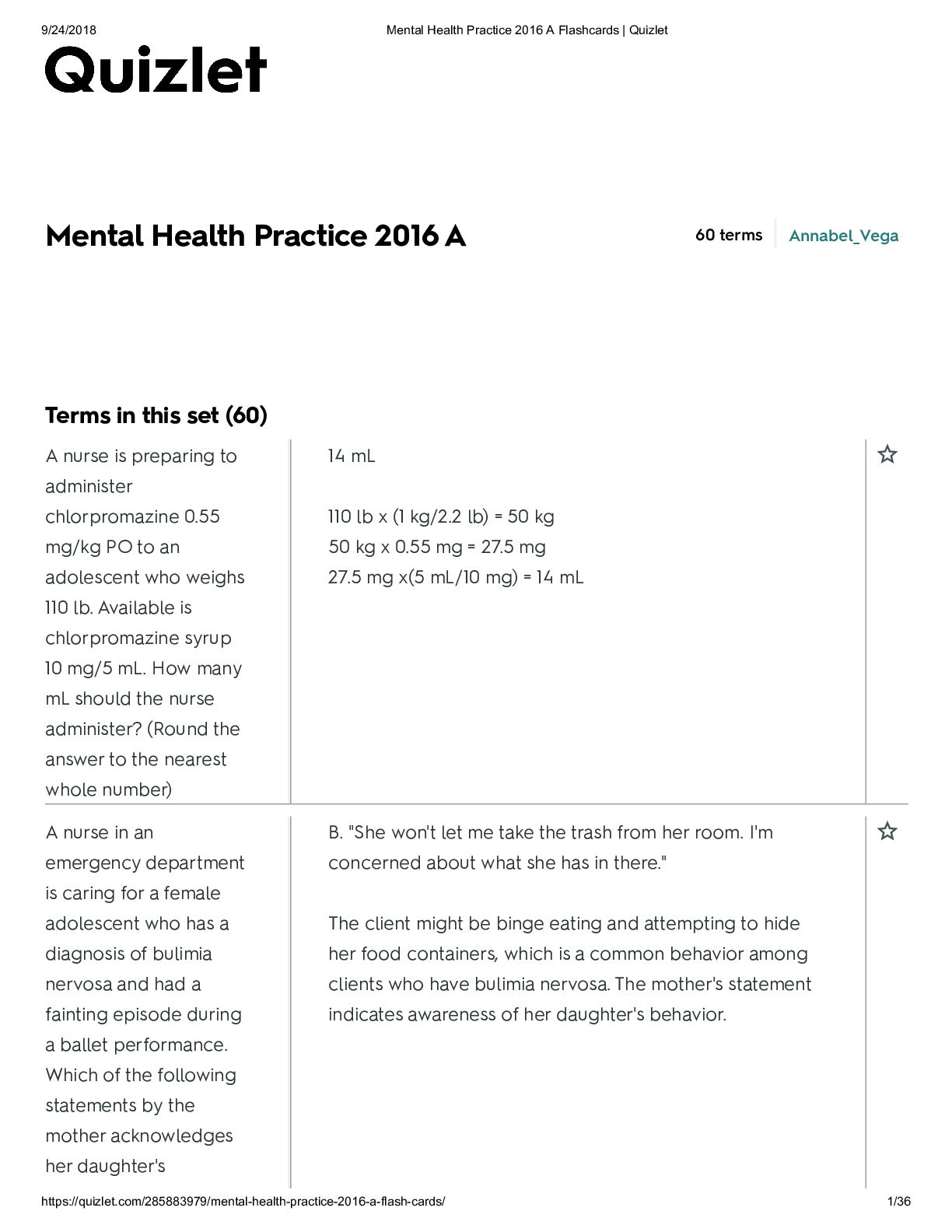
Reviews( 0 )
Document information
Connected school, study & course
About the document
Uploaded On
Jan 04, 2021
Number of pages
36
Written in
Additional information
This document has been written for:
Uploaded
Jan 04, 2021
Downloads
0
Views
87



